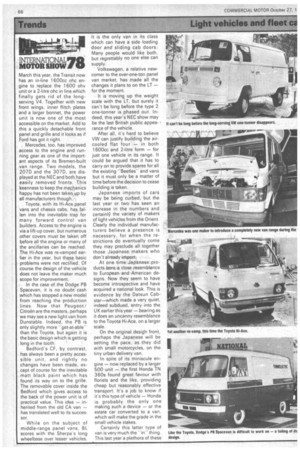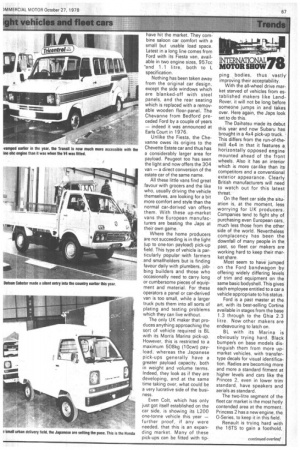INTERNATIONAL a
Page 67

Page 68

Page 69

If you've noticed an error in this article please click here to report it so we can fix it.
MOTOR SHOW
lap one-ton threat
3ERIOD of consolidation. I updating of existing
de's, rather than the intro tion of new models, is the id I detect in the light iicle market from all lufacturers who were wving at NEC, writes ve Gray. At the same time le of the larger manufacors have taken the oppority to rationalise their les.
he Austin, Morris, Landerlight commercial group of
-las, for example, replaced petrol 1600 and 1800cc eries power units in the rpa with one single engine,
1700cc 0-Series. This over-. I cam engine is the latestBL and features an iinium cylinder head on a block. The camshaft is driven.
hus the number of engines oduces has been cut — the )ries is used in Marina and :.:ess cars — and therefore 'es availability should be ?r. Payload too is up as the unit weighs less than either e two it replaces.
he manufacturers of matt < paint must be laughing all Nay to the bank. Everybody ls to be using the stuff in e of chrome for grilles, pers and what was formerly
-it trim. BL is no exception. only does the Sherpa range lefitfrom matt black ex) r trim, but so does the na van.
S part of Michael Edwars plan to re-introduce )us names, the Marina vans lost their rather meaningAustin-Morris tag and are all called Morris. Presum they are still made at the ) places as before. Another BL rationalisation is the use of ,metric designation for gross weights of the Sherpas. Thus the Sherpa 240 becomes the 250 (2.5 tonnes gross as opposed to 2.4 tons).
While fitting the 0-Series to the Sherpa has saved weight, engine accessibility is not much improved, although the distributor mounted on the cam cover is easier to reach.
Other manufacturers, though, have improved underbonnet accessibility, either by replacing engines or by redesigning the front end of the vehicle.
A good example is Ford with the Transit. Re-vamped in continued overleaf
March this year, the Transit now has an in-line 1600cc ohc engine to replace the 1 600 ohv unit or a 2-litre ohc in line which finally gets rid of the longserving V4. Together with new front wings, inner flitch plates and a larger bonnet, the power unit is now one of the most accessible on the market. Add to this a quickly detachable front panel and grille and it looks as if Ford has got it right.
Mercedes, too, has improved access to the engine and running gear as one of the important aspects of its Bremen-built van range. Two models, the 207D and the 307D, are displayed at the NEC and both have easily removed fronts. This keenness to keep the mechanics happy has not been taken up by all manufacturers though.
Toyota, with its Hi-Ace panel vans and chassis cabs, has fallen into the inevitable trap for many forward control van builders. Access to the engine is via a lift-up cover, but numerous other covers must be taken off before all the engine or many of the ancillaries can be reached. The Hi-Ace was re-vamped ear'Her in the year, but these basic problems were not rectified. Of course the design of the vehicle does not leave the maker much scope for improvement.
In the case of the Dodge PB Spacevan, it is no doubt cash which has stopped a new model from reaching the production lines. Now that Peugeot/ Citroen are the masters, perhaps we may see a new light van from Dunstable. Indeed, the PB is only slightly more "get-at-ablethan the Toyota, but again it is the basic design which. is getting long in the tooth.
Bedford's CF, by contrast, has always been a pretty accessible unit, and rightly no changes have been made, except of course for the inevitable matt black paint which has found ts way on to the grille. The removable cover inside the Bedford which gives access to the back of the power unit is of practical value. This idea — inherited from the old CA van — has translated well to its successor.
While on the subject of middle-range panel vans, BL scores with the Sherpa's long wheelbase over lesser vehicles. It is the only van in its class which can have a side loading
door and sliding cab doors.. Many people would like both, but regrettably no one else can supply. .
Volkswagen, a relative newcorner to the over-one-ton panel van market, has made all the changes it plans to on the LT — for the moment.
It is moving up the weight scale with the LT, but surely it can't be long before the type 2 one-tonner is phased out. Indeed, this year's NEC show may be the last British public appearance of the vehicle.
After all, its hard to believe VW can justify building the air cooled flat four — in both 1600cc and 2-litre form — for just one vehicle in its range. It
'could be argued that it has to carry on to provide spares for all the existing -Beetlesand vans but it must only be a matter of time before the decision to cease building is taken.
Japanese imports of cars may be being curbed, but the last year or two has seen an increase in the numbers and certainljt the variety of makers of light vehicles from the Orient. Clearly the individual manufacturers believe a presence is necessary, for when the restrictions do eventually come they may preclude all together those Japanese makers who don't already import.
At one time Japanese products bore a close resemblance to European and American de signs. Now they seem to have become introspective and have acquired a national look. This is evidence by the Datsun Cabstar—which made a very quiet, indeed subdued, entry into the UK earlier this year — bearing as it does an uncanny resemblance to the Toyota Hi-Ace, on a larger scale.
On the original design front, perhaps the Japanese will be setting the pace, as they did with small motorcycles, on the tiny urban delivery van.
In spite of its miniscule engine — now replaced by a larger • 500 unit — the first Honda TN 360s found great favour with florists and the like, providing cheap but reasonably effective transport. Its a job to know if it's this type of vehicle — Honda is probably the only one making such a device — or the estate car converted to a van, which will make the grade in the small vehicle stakes.
Certainly this latter type of van is very much the "in" thing. This last year a plethora of these have hit the market. They combine saloon car comfort with a small but usable load space. Latest in a long line comes from Ford with its Fiesta van, available in two engine sizes, 957cc and 1.1 litre, both to L specification.
Nothing has been taken away from the original car design, except the side windows which are blanked-off with steel panels, and the rear seating which is replaced with a removable wooden floor-panel. The Cheyenne from Bedford preceded Ford by a couple of years — indeed it was announced at Earls Court in 1976.
Unlike the Fiesta, the Cheyenne owes its origins to the Chevette Estate car and thus has a considerably larger area for payload. Peugeot too has seen the light and now offers the 304 van — a direct conversion of the estate car of the same name.
All these little vans find great favour with grocers and the like who, usually driving the vehicle themselves, are looking for a bit more comfort and style than the normal car-derived van offers them. With these up-market vans the European manufacturers are beating the Japs at their own game.
Where the home producers are not succeeding is in the light (up to one-ton payload) pick-up field. This type of vehicle is particularly popular with farmers and smallholders but is finding favour daily with plumbers, jobbing builders and those who occasionally need to carry long or cumbersome pieces of equipment and material. For these operators a panel or car-derived van is too small, while a larger truck puts them into all sorts of plating and testing problems which they can live without. .
The only UK maker that produces anything approaching the sort of vehicle required is BL with its Morris Marina pick-up. However, this is restricted to a maximum 508kg (1 Ocwt) payload, whereas the Japanese pick-ups generally have a greater payload capacity, both in weight and volume terms. Indeed, they look as if they are developing, and at the same time taking over, what could be a very lucrative side of the business.
Even Colt, which has only just got itself established on the car side, is showing its L200 one-tonne vehicle this year — further proof, if any were needed, that this is an expanding market. Many of these pick-ups can be fitted with tip-,
ping bodies, thus vastly. improving their acceptability.
With the all-wheel drive market starved of vehicles from established makers like LandRover, it will not be long before someone jumps in and takes over. Here again, the Japs look set to do this.
The Daihatsu made its debut this year and now Subaru has brought in a 4x4 pick-up truck. This differs from the run-of-themill 4x4 in that it features a horizontally opposed engine mounted ahead of the front wheels. Also it has an interior which is more car-like than its competitors and a conventional exterior appearance. Clearly British manufacturers will need to watch out for this latest threat.
On the fleet car side the situation is, at the moment, less worrying for UK producers. Companies tend to fight shy of purchasing even European cars, much less those from the other side of the world. Nevertheless complacency has been the downfall of many people in the past, so fleet car makers are working hard to keep their market share.
Most seem to have jumped on the Ford bandwagon by offering widely differing levels of trim and equipment on the same basic bodyshell. This gives each employee entitled to a car a vehicle appropriate to his status.
Ford is a past master at the art, with its best-selling Cortina available in stages from the base 1.3 through to the Ghia 2.3 litre. Now other makers are endeavouring to latch on.
BL with its Marina is obviously trying hard. Black bumper's on base models distinguish them from more upmarket vehicles, with transfertype decals for visual identification. Radios are becoming more and more a standard fitment at higher levels and cars rike the Princes 2, even in lower trim standard, have speakers and aerials as standard.
The two-litre segment of the fleet car market is the most hotly contended area at the moment. Princess 2 has a new engine, the 0-Series, to keep it in this field.
Renault is trying_ hard with the 16TS to gain a foothold,
































































































































































